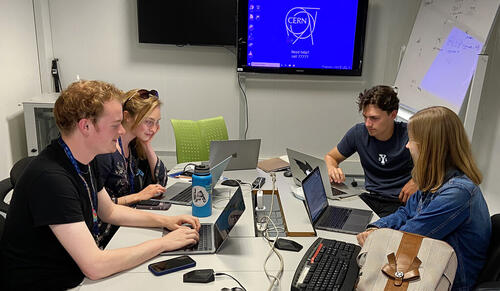
Yale undergraduate seniors Caitlin Gainey, Dawson Thomas, Matthew Murphy, and Alexandra Haslund-Gourley spent their 2022 summer vacation conducting critical research at one of the world’s most important physics hubs — the Large Hadron Collider at CERN (the European Organization for Nuclear Research), located just outside Geneva, Switzerland. They were part of a science team led by Sarah Demers, professor of physics and a member of Yale’s Wright Lab.
The Yale students’ job was to analyze test collisions of subatomic particles, look for specific particles such as Z bosons and J/Psi particles, and create visual displays of the collisions. The work involved an intensive amount of physics knowledge, computer coding, and graphics expertise.
Their visit coincided with the 10th anniversary of the discovery of the Higgs boson, a fundamental particle on the order of an electron or quark, a landmark moment celebrated by CERN scientists in July. During the same month, CERN announced the discovery of three new particles — a pentaquark and two tetraquarks — using a more powerful accelerator beam.
Event displays created by the Yale students, which illustrated specific particle collisions, were a prominent part of the announcement.
“It was an exciting time to be at CERN, and these students were in the thick of it,” said Demers, a CERN associate research scientist, collaborator with the ATLAS experiment at LHC, and part of the international research team that discovered the Higgs boson (along with fellow Wright Lab professors Keith Baker and Paul Tipton).
“I’m incredibly impressed with what they accomplished,” she said.
This article was excerpted and adapted from an article by Jim Shelton of Yale News. To read the full article for more information about the students and their work, please see the article at the link below.

